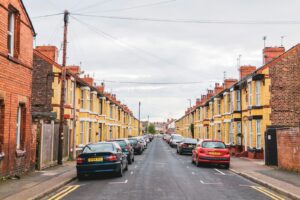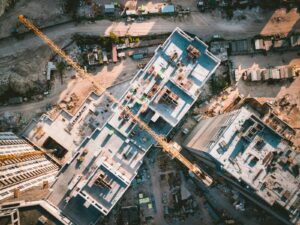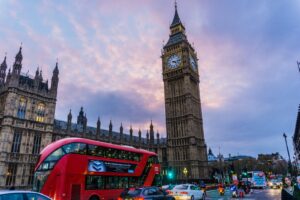What if London were a national park?
 If space in the city is shaped by our interpretation, then changing our approach to space should fundamentally change the city. Theoretically, at least, this may be true.
If space in the city is shaped by our interpretation, then changing our approach to space should fundamentally change the city. Theoretically, at least, this may be true.
And it’s this theory that has in part informed the geographer Daniel Raven-Ellison’s reasoning in his recently launched campaign to reposition London, not as a city, but as a national park.
Given the prominence of air pollution in the news of late this may be a timely suggestion. In spite of the differing reactions to recent smog episodes in London and Paris, neither city has subsequently introduced any measure to address the underlying problem of high air pollution over the long-term. Perhaps a radical rethinking of what urban space is, and what it means to us, is a crucial part of the process that will help reduce the toxicity of our cities.
Why should we accept that our cities are inevitably polluting? The only logical answer to this question is, of course, that we shouldn’t. And we don’t. A cursory examination of the growing levels of recycling, cycling and green businesses in the UK indicates that throughout our cities people are pursuing more sustainable ways of life. So what’s the problem then?
Well, despite this progress towards greener lifestyles at an individual level, cities still present us with significant environmental challenges, which will intensify as the planet continues urbanising. The World Health Organisation recently found that air pollution might be responsible for up to one in every eight deaths worldwide, something directly relevant to UK given that the health costs of associated air pollution are estimated as double those of obesity.
This is compounded by the loss of green space in our cities. In London, despite residents’ love for the many physical aspects of city life that connect us to nature – trees, parks, gardens, allotments –, between 2009-2012 the city lost the equivalent of one and a half Hyde Parks in terms of open space land, a whopping 215 hectares, according to the London Assembly’s environment committee.
Although we use the body as a metaphor for the city, in that we interchangeably use arteries and roads, and refer to our city centres as hearts, it would appear that we don’t care for our built areas in the same way. But perhaps this metaphor is not misplaced. Research by Geoffrey West suggests that urban areas follow the same metabolic laws as other organisms: they are essentially living entities. So if cities are living creatures in their own right should we change our approach to them?
The context of recent air pollution spikes that have highlighted the environmental and health challenges faced by contemporary cities is an opportune moment to re-examine our perception of the city. If the city is understood as a natural phenomenon then maybe we will approach it as such. This could mean that ideas such as urban motorways becoming green arteries, proposed by Bell Phillips Architects, and re-purposing London’s disused postal railway network as a new eco-distribution network to displace lorry-dependent development, as suggested by Sam Jones from FAT, wouldn’t seem so radical and could become closer to reality.
To change the course of our current polluting city trajectory, we should re-examine our relationship with our built environment. Understanding London as a national park could enable this transformation while helping us to celebrate the complexities of the city as an ecosystem.
Imagine if London’s ongoing development boom was unfolding in the setting of a national park? In this context the city’s ability to meet its polluting challenges while establishing public places that promote biodiversity, reduce carbon emissions, and improve city flood defences, may not be so inconceivable.
















In June 2001 George Monbiot did a piece on his website about London’s transformation into a ‘greened city’. This followed research by the New Scientist magazine on what might happen if London was abandoned. This concluded that London would revert to marsh land.
His piece is interesting as it raised similar issues to this article on air pollution and London’s environmental impact proportionate to its size. He made the point, increasingly relevant, that London became non-sustainable as soon it began its industrial growth. Amongst its issues were food supply and waste management. New technology and cheap fossils fuels provided London with solutions and indeed gave the city a sense of resilience, but these have also meant a wide cost to the environment. It is also the case that the preferred solutions rejected older and less harmful processes such as recycling waste to grow food inside the city.
Other growth cities used similar models and coping strategies, thus compounding London’s solutions globally. In the modern era such cities are now intrinsically linked and seem dependent upon global network for trade, replenishment, and even culture. This has all the symptoms of a highly complex unbounded system, whereby the potential of stress from new and emergent change will create complex tensions and reveal fragility.
Yet it is tempting to consider cities as organic systems and as such interpret them within a much narrower grasp of human understanding. After all, if we can map the genome, we can map the city. But cities don’t self-organise, and adapt like nature. A prefab (sprout) does not become a Gherkin. Cities are man-made constructs, based upon economics, human intellect, technology and what we used to call society. Cities do not evolve by natural selection and in facing natural disasters are found wanting. In fact, some cities struggle with basic natural occurrences such as excess rain, snow, tide, or sun.
Whereas unbounded change in open organic systems is slow, perpetual and incremental (and often bestows beneficial adaption to nature), change in human systems is different. Think of a political revolution. In this respect how many people foresaw the Arab Spring; certainly not the CIA. This was inspired by Wikileaks and social media, which themselves are constructs of the networked city; yet neither existed 20 years ago. This has profound implications for our future and point to even more techno-mechanistic urbanism and not organic urbanism.
It is also a fact that air pollution did not evolve this year. It’s been around for a long time, yet we chose to ignore both it and the science that revealed its consequences. The human pack mentality is to ignore what we don’t like. And whilst some natural plant systems have adapted to higher CO2 levels, increased alkaline conditions, and the urban heat island effect, humans have not. It is killing many of us, so adaptability is also relative.
As for National Park status, research in Canada and Australia suggests that many National Parks are now far from natural. The ‘historic ecologies’ that the parks were set up to protect have morphed into what ecologists call ‘novel ecologies’. London is a typical example, given that novel ecologies are places re-defined by human behaviour. This interaction increasingly afflicts wilderness areas as much as it does urban areas.
As for my most recent experience of a UK National Park, the Lake District this Easter, I had little practical choice but to drive there. I found it difficult to park when I got there, and true to nearly all cognitive human behavioral traits, I found that thousands of my fellow humans were doing the same thing. It made more sense to park myself in the city!